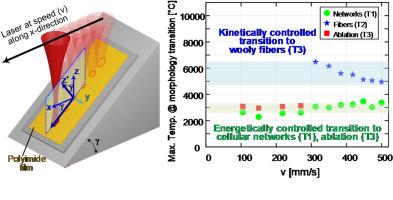Kinetic effects and ablation thresholds in laser-induced graphene
IF 11.6
2区 材料科学
Q1 CHEMISTRY, PHYSICAL
引用次数: 0
Abstract
Laser-induced graphitization of polymers is promising for flexible electronics applications. While the effects of laser power on the structure and properties of the laser-induced graphene (LIG) have been elucidated, the role of kinetic effects is still largely unexplored. We use a unique approach of lasing individual electrodes on a tilted polyimide sheet, which allows scanning a continuum of laser fluence on a single lased line as the degree of beam defocus varies spatially. This approach is ideal for revealing discrete morphological transitions and mapping structural and chemical changes. To reveal how LIG formation is energetically or kinetically controlled, three morphological transitions are revealed: T1, from porous to cellular networks; T2, from cellular networks to wooly fibers; and T3, ablation threshold that occurs only at low speeds (<300 mm/s). This newly identified transition is characterized by a cratered top and hierarchical porosity with improved graphene quality. We demonstrate that wooly fiber formation is highly speed-dependent and that fibers only form at high speeds (>300 mm/s). Moreover, by integrating experimental measurements with thermal modeling, we find that both the cellular-network formation and the ablation transitions are rate-independent, as they occur at the temperatures of polyimide graphitization and ablation of graphitic material, respectively. In contrast, our findings show that the formation of wooly fibers is highly rate dependent, as it occurs at temperature ramp rate of ≈107 °C/s. Hence, our results provide new insights into the kinetics of the physicochemical LIG process, toward tailoring porous graphene for different applications.

激光诱导石墨烯的动力学效应和烧蚀阈值
激光诱导聚合物石墨化在柔性电子应用中具有广阔的前景。虽然激光功率对激光诱导石墨烯(LIG)结构和性能的影响已经被阐明,但动力学效应的作用仍然很大程度上未被探索。我们使用了一种独特的方法,即在倾斜的聚酰亚胺片上对单个电极进行激光照射,这使得随着光束离焦程度的空间变化,可以在单个激光线上扫描连续的激光影响。这种方法是理想的揭示离散形态转变和映射结构和化学变化。为了揭示LIG的形成是如何受到能量或动力学控制的,揭示了三种形态转变:T1,从多孔到细胞网络;T2,从蜂窝网络到羊毛纤维;T3,仅在低速(<300 mm/s)时发生的烧蚀阈值。这种新发现的转变的特点是顶部有坑洞,分层孔隙率提高了石墨烯质量。我们证明了羊毛纤维的形成高度依赖于速度,并且纤维只在高速下形成(>;300毫米/秒)。此外,通过将实验测量与热建模相结合,我们发现细胞网络的形成和烧蚀转变都是速率无关的,因为它们分别发生在聚酰亚胺石墨化和石墨材料烧蚀的温度下。相反,我们的研究结果表明,羊毛纤维的形成高度依赖于速率,因为它发生在≈107°C/s的温度斜坡速率下。因此,我们的研究结果为物理化学LIG过程的动力学提供了新的见解,为不同的应用定制多孔石墨烯。
本文章由计算机程序翻译,如有差异,请以英文原文为准。
求助全文
约1分钟内获得全文
求助全文
来源期刊

Carbon
工程技术-材料科学:综合
CiteScore
20.80
自引率
7.30%
发文量
0
审稿时长
23 days
期刊介绍:
The journal Carbon is an international multidisciplinary forum for communicating scientific advances in the field of carbon materials. It reports new findings related to the formation, structure, properties, behaviors, and technological applications of carbons. Carbons are a broad class of ordered or disordered solid phases composed primarily of elemental carbon, including but not limited to carbon black, carbon fibers and filaments, carbon nanotubes, diamond and diamond-like carbon, fullerenes, glassy carbon, graphite, graphene, graphene-oxide, porous carbons, pyrolytic carbon, and other sp2 and non-sp2 hybridized carbon systems. Carbon is the companion title to the open access journal Carbon Trends. Relevant application areas for carbon materials include biology and medicine, catalysis, electronic, optoelectronic, spintronic, high-frequency, and photonic devices, energy storage and conversion systems, environmental applications and water treatment, smart materials and systems, and structural and thermal applications.
 求助内容:
求助内容: 应助结果提醒方式:
应助结果提醒方式:


